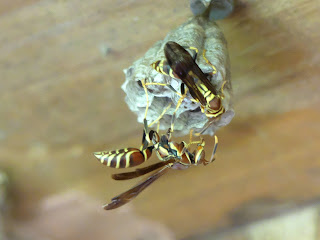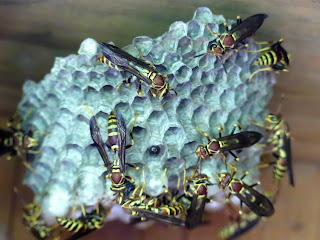Guinea Paper Wasps
This summer I spotted some Guinea Paper Wasps. Based on the name, I thought the might be an invasive species from Guinea, or a namesake like Equitorial Guinea, Guinea-Bissau, Papua New Guinea, or Western New Guinea. But it turns out they are a native species, and it's surmised that the name came from this locality in Virginia or this other locality in Virginia. (They're more American than any Europeans, or any other humans.)
These wasps are considered paper wasps since they make nests by chewing up wood and other tough plant fibers to make their papery nests. (Paper wasp isn't a great taxonomic term though, since some of their close relatives make mud nests while some distantly related wasps make paper nests.)
They are eusocial insects, meaning they collectively share in the raising of young, a nest supports multiple generations, and the nest has a hierarchy of roles. Unlike some eusocial insects though, there's no apparent anatomic difference between the (all female) workers and the queen. And if a nest's queen should die, a senior work wasp will usually "grab the throne" and reign as the new queen.
Most of the native paper wasp species are considered to be fairly peaceful; certainly I wasn't attacked or obviously threatened when I was inside the structure taking these pictures. (By way of contrast, the invasive European Paper Wasp has a reputation for being as unfriendly as yellowjackets.)
I suspect this first picture is a satellite nest, basically a new nest relatively close to the main nest. I'd imagine this is an early satellite nest, and (if all goes well) will be larger later in the summer. These nests are still affiliated with the main nest, and basically help colony survival if the main nest is attacked by parasites, predators, weather, etc.
 |
| July 30, 2021 at Negri Nepote Native Grassland Preserve Photo 149012522, (c) jpviolette, some rights reserved (CC BY-NC) |
This second picture is likely to be the main nest, though I suppose it could be subordinate to an even larger main nest in the area. (This seems unlikely though, since the wasps were using a roofed bird blind with no similar structures or large trees in the immediate vicinity.)
 | |
| July 30, 2021 at Negri Nepote Native Grassland Preserve Photo 149012605, (c) jpviolette, some rights reserved (CC BY-NC) |



Comments
Post a Comment